
As part of the [Re:]Entanglements project we have sought to document the material culture collections assembled by Northcote Thomas during his anthropological surveys in Nigeria and Sierra Leone as thoroughly as possible. An important aspect of this has been to photograph the collections at the University of Cambridge Museum of Archaeology and Anthropology stores, and then to use the photographs during our fieldwork activities in which we have been revisiting the communities from which they were originally sourced.
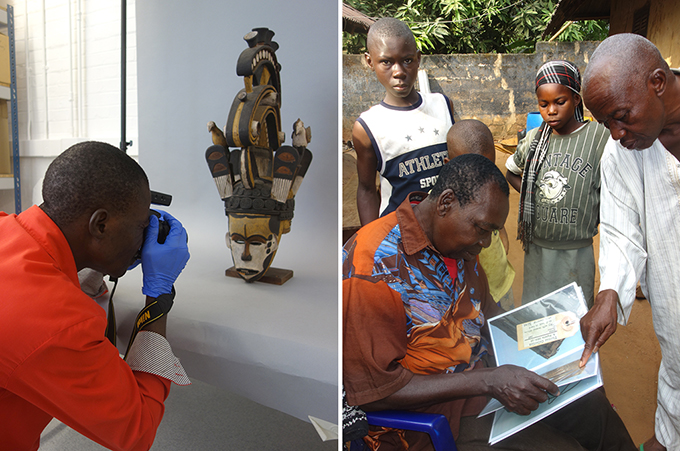
As we have been pursuing this research, we have encountered various other photographs of the Northcote Thomas collections. Indeed, we have discovered that some objects in the collections have been photographed many times since they were collected – starting in 1909 with Northcote Thomas’s own field photographs. In this article, we bring some of these photographs together as a kind of visual history of the photographic documentation of the collections.
The relationship between photography, ethnographic objects and ethnographic display has been the subject of much academic discussion. The manner in which objects have been photographed has shaped how such objects have been perceived, often within a strong Western modernist aesthetic, constituting them as ‘art objects’. Walker Evans‘ photographic documentation of African masks and sculptures displayed at the ‘African Negro Art‘ exhibition at the Museum of Modern Art, New York in 1935 is a famous case and has been the subject of an exhibition and catalogue in its own right – Perfect Documents. As well as lighting and framing, a key part of this aesthetic is the separation of an object from its context, accentuating the object’s formal qualities, while disembedding it from the cultural context that often gives an object its original meaning and significance. This practice was evident in Northcote Thomas’s own use of a blank photographic background sheet, and it is there, too, in our own photographic documentation of the objects. It has been difficult to escape these dominant photographic tropes, although we have also tried to experiment with other approaches in our creative collaborations with local artists.
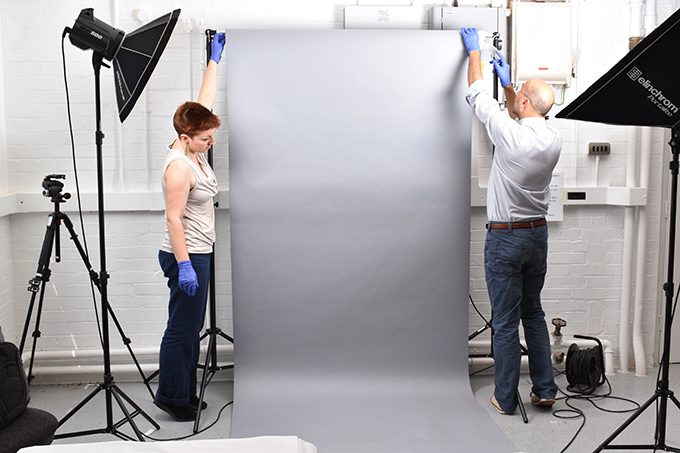
Northcote Thomas, 1909-15
Northcote Thomas made extensive use of photography during his anthropological surveys as we have discussed in many other project blog posts. While much of his photographic documentation was focused on people and their cultural practices, he also devoted considerable energy to photographing local material culture, including everyday utensils, tools and technologies, as well as ‘decorative art’ and objects associated with ceremonies, rituals and ‘secret societies’. Much of this material culture was photographed in situ in its cultural as well as physical context. Very occasionally it appears that Thomas acquired objects that he had first photographed in their original context, such as this ikenga-like figure that Thomas collected in Fugar in the north of present-day Edo State, Nigeria.
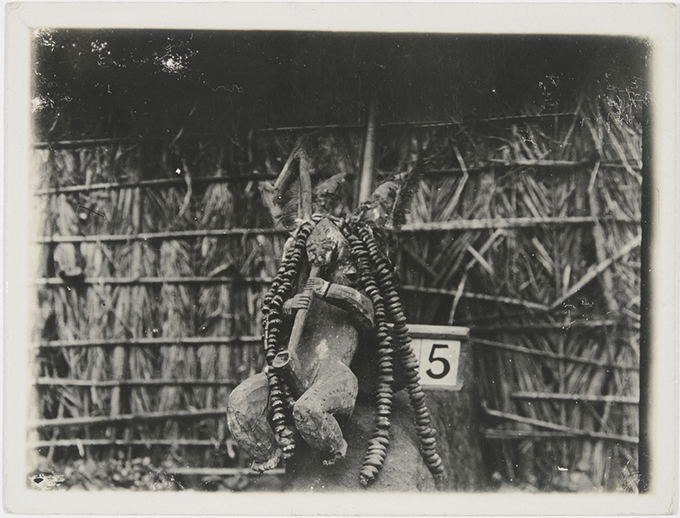
In addition to photographing objects in situ, Thomas also photographed objects isolated from their cultural context. This is evident, for example, in these photographs of masks collected by Thomas during his first and second tours respectively. Thomas photographed many masquerade performances, showing how masks were just a part of a much more elaborate performative display that included full costumes, music, dance, other ceremonial objects and audience interaction. On occasion, he was able to collect entire masquerade costumes, but, as with other collectors, he also collected head pieces alone. While we do not know the circumstances in which he collected these for sure, we do know that at least some of the objects he collected were specially commissioned from artists – this may have been the case with these masks from Fugar and Agukwu. Note the physical arrangement of the masks from Fugar on the left, and the use of backdrop and a book as an improvised mount in the photograph on the right.
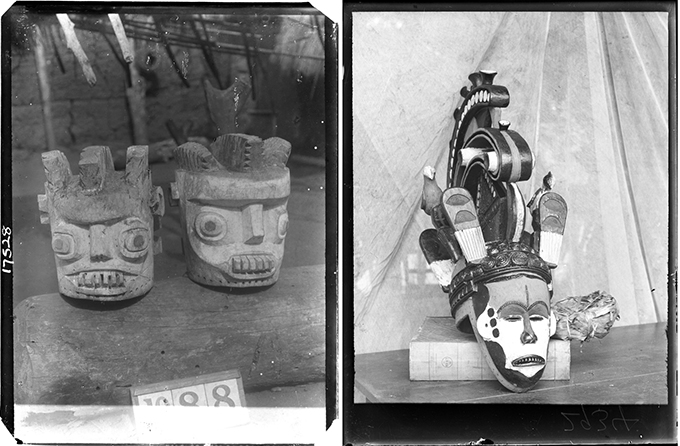
During Thomas’s second tour, which focused on the Igbo-speaking peoples of what was then Awka District (present-day Anambra State, Nigeria), Thomas started lining up the objects he had collected to photograph them prior to having them shipped to the University of Cambridge Museum of Archaeology and Anthropology (then known as the Museum of Archaeology and Ethnology). This example shows a series of items with Thomas’s original object numbers (352 to 372), collected in Awgbu and Enugu Ukwu. One can get a good sense of Thomas’s photographic backcloth here, supported on bamboo canes, which were in turn supported by two assistants, whose hands can be seen on either side! These photographs have been extremely useful in identifying Thomas’s collections in the Museum’s stores today, since many objects have since become separated from their labels. We have not, however, been able to locate all these objects.
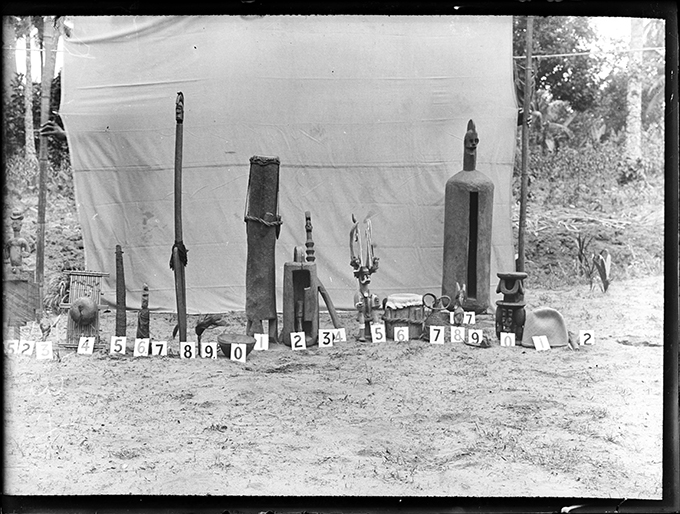
Arts of West Africa, 1935
To date, the earliest photographs we have discovered of Thomas collections after they had entered the Museum of Archaeology and Ethnology in Cambridge were published in 1935, 20 years after Thomas returned from his final tour. These are two photographs of the same Aule mask collected by Thomas in Agenebode, North Edo, in 1909. They were published in a book entitled Arts of West Africa, which was commissioned by the UK’s Colonial Office following the recommendation of its Advisory Committee on Education in the Colonies. In the acknowledgements it is stated that the book’s plates were produced by the ‘expert photographers’ of the Empire Marketing Board, under the supervision of John Grierson, pioneer of the British Documentary Film Movement. It is also noted that ‘the British Museum afforded special facilities for the photography of [the] objects’, including those lent by other museums. It is likely, therefore, that the Aule mask was sent to the British Museum to be photographed.

It is interesting that the editors of the book considered it worthwhile to illustrate the mask with two different views (it is the only example in the book). In the description of the mask in the text, reference is made to photographs taken by Thomas of Igbo hair designs similar to those carved on the mask published in Peoples of All Nations in c.1920. The photographs show how lighting and camera angle can be used to dramatize the appearance of the mask.
British Museum, dates unknown
We have recently chanced upon a series of photographs of Northcote Thomas collections in the British Museum. Only one of these had a catalogue note mentioning the name of Thomas, but we were able to identify others and the British Museum catalogue will be updated accordingly. It is not clear whether the photographs were all taken at the same time, or if they were photographed at the British Museum or supplied to the Museum by Cambridge. Nor do we have any information about the year in which they were taken. It is possible that they were also photographed for the Arts of West Africa book, but not included – we don’t know.
Below we provide three examples, juxtaposed with our own photographs of the same objects. These highlight another value of historical photographs of objects, insofar as we are able to compare them with the objects as we encounter them today. The first photograph is of the same Aule mask collected by Thomas in Agenebode and published in Arts of West Africa. As can be seen in the recent photograph on the right, the mask has been fitted onto a wooden display mount. These mounts are also evident in some of the Len Morley photographs taken in the late 1940s. This mount is not present in the British Museum photograph of the same mask on the left, suggesting that the photograph was indeed taken earlier – perhaps in the 1930s.
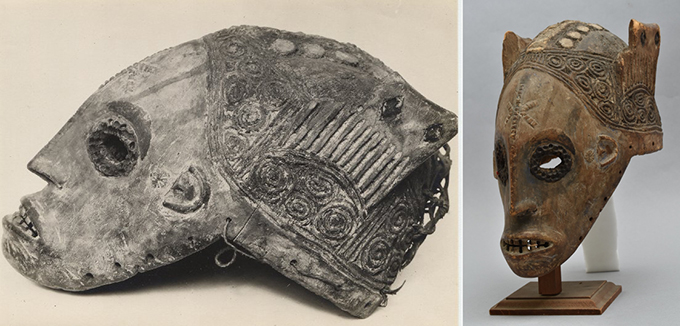
Comparing historical and contemporary photographs also allows us to gather information about the changing condition of objects. The foot of this ngene shrine figure from Awgbu, for example, has clearly been damaged since the British Museum photograph on the left was made. Actually, during our collections-based research, we have located the missing part of the foot and this figure will be repaired prior to being displayed at the [Re:]Entanglements project exhibition at the Museum of Archaeology and Anthropology, Cambridge, in 2021-22.
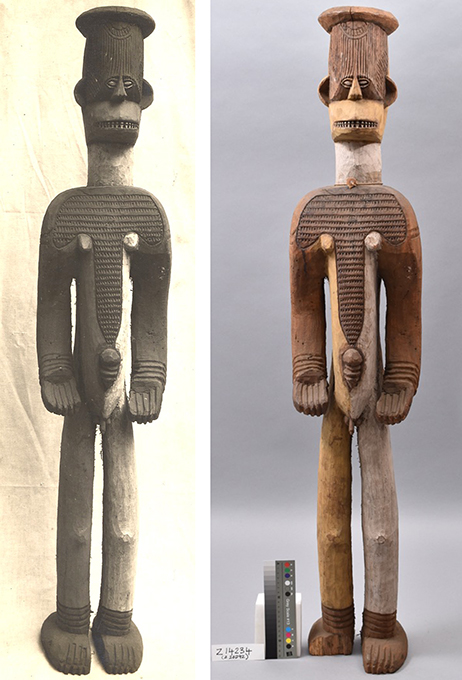
In the example below, we can see that a piece of patterned cloth was originally attached to the mask when it was collected and has subsequently been lost. In fact, on closer inspection, we see that this is the same Obo mask collected in Fugar that Morley photographed (see below). The negative of Morley’s photograph has been printed back to front, such that the large crack that appears on the left side of the helmet can be see on the opposite side. The fact that the mask is attached to a wooden mount in Morley’s photograph of 1949, but is no longer attached to the cloth, also suggests that the British Museum photographs are earlier. Today, both the cloth and the wooden mount are missing.

Len Morley, 1949-51
In 1947, a faculty photographer was appointed to work in the Anthropology and Archaeology sections of Cambridge University, including at the Museum of Archaeology and Anthropology – his name was Len Morley. He continued working at the Museum until 1974. To date we have been able to identify around 15 objects from the Thomas collections photographed by Morley between 1949 and 1951. The objects are taken against a plain background and include a small scale. Two of the masks in the examples below have been fitted with wooden mounts similar to that discussed above, giving an indication of how they would have been exhibited in the Museum at the time.
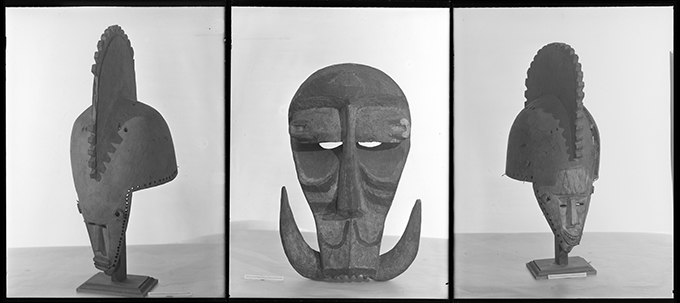
Some masks are difficult to photograph without expensive purpose-designed mounts due to their shape and weight-distribution. In one remarkable photograph taken by Len Morley, we can see how he addressed this problem by getting an assistant, or perhaps a member of the Museum’s curatorial staff, to wear the mask. The area around the mask has then been painted out on the print making it suitable for publication purposes.
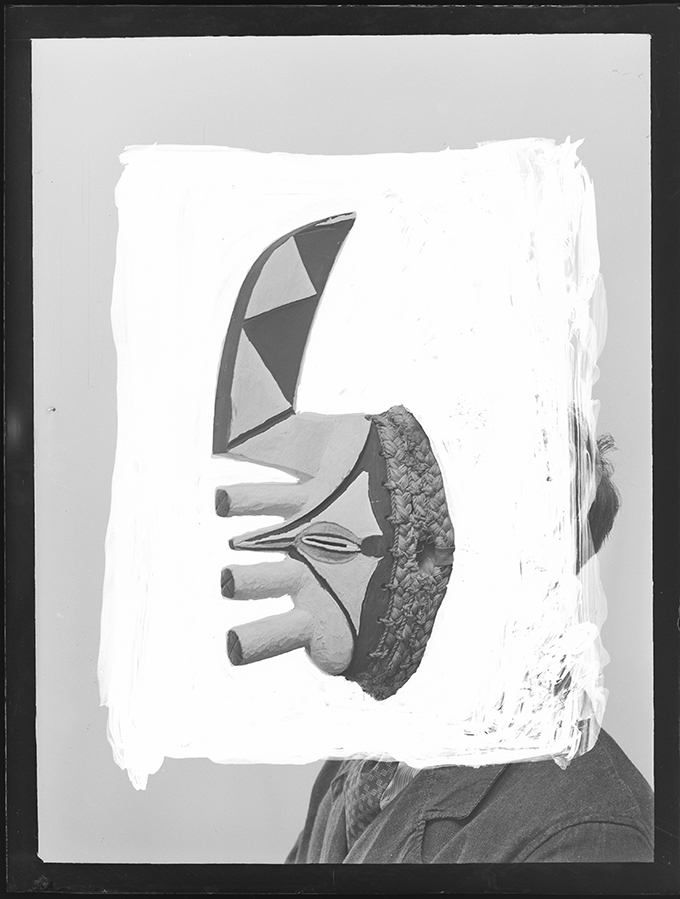
African art publications, 1960s-80s
A number of objects from the Northcote Thomas collections have featured as plates in more recent popular reference works on African art. In African Sculpture by William Fagg and Margaret Plass, first published in 1964, the authors use explicitly European art historical vocabularies to discuss African objects. At the time the book was published, Fagg was Deputy Keeper of Ethnography at the British Museum. Margaret and Webster Plass were American collectors of African art; Margaret donated their collection to the British Museum after her husband Webster’s death in 1952.
Fagg and Plass use the example of a mask Thomas identifies as agbazi, which was collected in Fugar in 1909 to illustrate what they refer to as an ‘African Gothic’ style (‘the strong tendency towards a ‘Gothic‘ verticality in African woodcarving’, p.101). The mask, which also appears in the photographs at the top of this post, appears to have been photographed lying on the floor of the Museum of Archaeology and Anthropology in Cambridge.
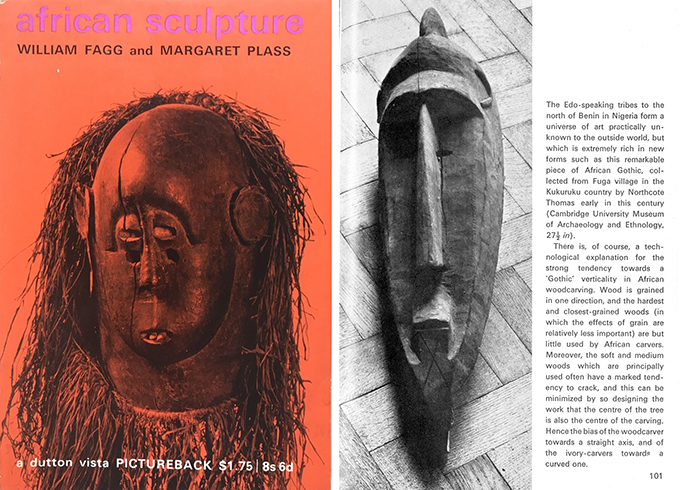
Like William Fagg, Frank Willett was a leading Africanist anthropologist and archaeologist. Having spent a number of years working in the antiquities department in Nigeria in the 1950s, at the time he published his classic survey of African art in 1971 he was Professor of African Art and Archaeology at Northwestern University in the USA. African Art has remained in print ever since, and was revised in 2002. Willett used a photograph of a carved wooden figure Thomas collected in Sabongida, in the so-called Ora country, north of Benin City in his introductory chapter, discussing the development of the study of African art.
Willett refers to the ‘cubist qualities’ reflected in the artistic traditions of the Edo-speaking peoples. He also notes how little known these artistic traditions are when compared to the ‘better known art of the Benin court’. Thomas’s label and catalogue entry describe the figure merely as a doll. A piece of string is tied around its neck, attached to which are two cowrie shells.

A photograph of the Isi abogefi mask collected by Thomas in Agukwu, discussed above, was published by G. I. Jones in his monograph, The Art of Eastern Nigeria, published in 1984. Gwilym Iwan Jones was a colonial administrator in Igbo-speaking Eastern Nigeria between 1926 and 1946. During his time in the Colonial Service he undertook anthropological training at Oxford. In 1946, he left the Colonial Service and became a lecturer in anthropology at the University of Cambridge, specializing in Igbo art. Jones made extensive collections himself, now in the Museum of Archaeology and Anthropology, and he was also an expert photographer – his photographs of Igbo masquerade performances are especially well-known. In the 1930s and 40s, he worked in many of the same areas that Thomas visited during his second and third tours (1910-13), and he makes frequent reference to Thomas’s collections in the book.
Jones uses the mask as a particularly fine example of a ‘maiden spirit’ helmet mask. The marked-up, camera-ready artwork used in the production of Jones’ book can be found in the archives of the Museum of Archaeology and Anthropology, among Jones’ papers.
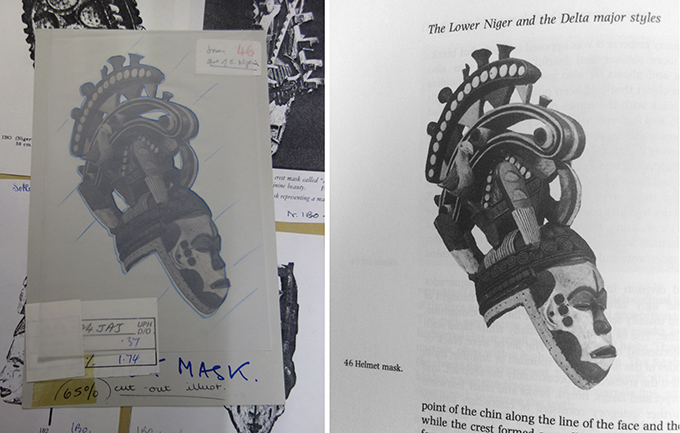
Jean Borgatti, 1969
In 1969, the art historian Jean Borgatti conducted the first comprehensive research on Northcote Thomas’s collections, focusing on the material he collected in North Edo sixty years previously. This research would form an important part of Borgatti’s MA dissertation, ‘The Northern Edo of Southern Nigeria: An Art Historical Geography of Akoko-Edo, Ivbiosakon, Etsako and Ishan’, submitted to the University of California, Los Angeles in 1971. Her decision to concentrate on this area was a response to William Fagg’s observation that ‘the arts of the Northern Edo and Ishan have remained “a universe … practically unknown to the outside world, but which is extremely rich in new forms”‘ (Borgatti 1971: 2). Building on her MA work, she would go on to conduct PhD research in the same region and, indeed, devote much of her career to studying the arts and masquerade of North Edo (see, for example, her guest blogs for the [Re:]Entanglements project).
Borgatti made extensive use of photography in her research on the Thomas collections at the Cambridge Museum of Archaeology and Anthropology, using formal analysis to categorize the artworks according to a series of ‘style provinces’. She focused especially on carved figures and mask types. As well as presenting the photographs in the appendix of her MA thesis, she used these in her PhD fieldwork, during which she would rephotograph many of the same masquerade types, providing a remarkable analysis of how they have changed and developed over several decades.
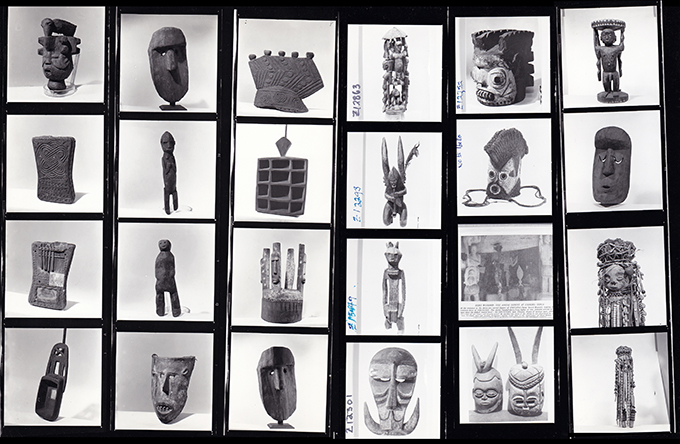
Roger Blench and Mark Alexander, 1983-90
Prior to the [Re:]Entanglements project, the most sustained attempt to document Northcote Thomas’s collections was carried out by Roger Blench and Mark Alexander in the 1980s. Blench and Alexander were graduate students in the Anthropology Department at Cambridge. Together they set about cataloguing Thomas’s papers, sound recordings, photographs and material culture collections across various institutions. Blench presented an overview of the results of this survey in an article, ‘The Work of N. W. Thomas as Government Anthropologist in Nigeria’, published in The Nigerian Field in 1995. They also published a bibliography of Thomas’s written works, while Alexander used Thomas as one of a number of case studies in his MPhil dissertation, ‘Colonialism and the Political Context of Collection: A Case Study of Nigerian Collections in the Cambridge Museum of Archaeology and Anthropology’, submitted in 1982.
As part of this work, Blench and Alexander created a computerized database of the Thomas collections and photographs in Cambridge, and photographed as many of the objects as they could locate. Blench notes that many seemed to be missing. In the early 1990s, Blench and Alexander pursued other interests and passed on their catalogue and photographs to the Museum of Archaeology and Anthropology. Their photographs are pinned to the reverse of the Thomas object index cards in the Museum’s original card index catalogue system. While we have made many discoveries since, Blench and Alexander’s work with Thomas’s collections may certainly be regarded as laying the foundations of the [Re:]Entanglements project.
